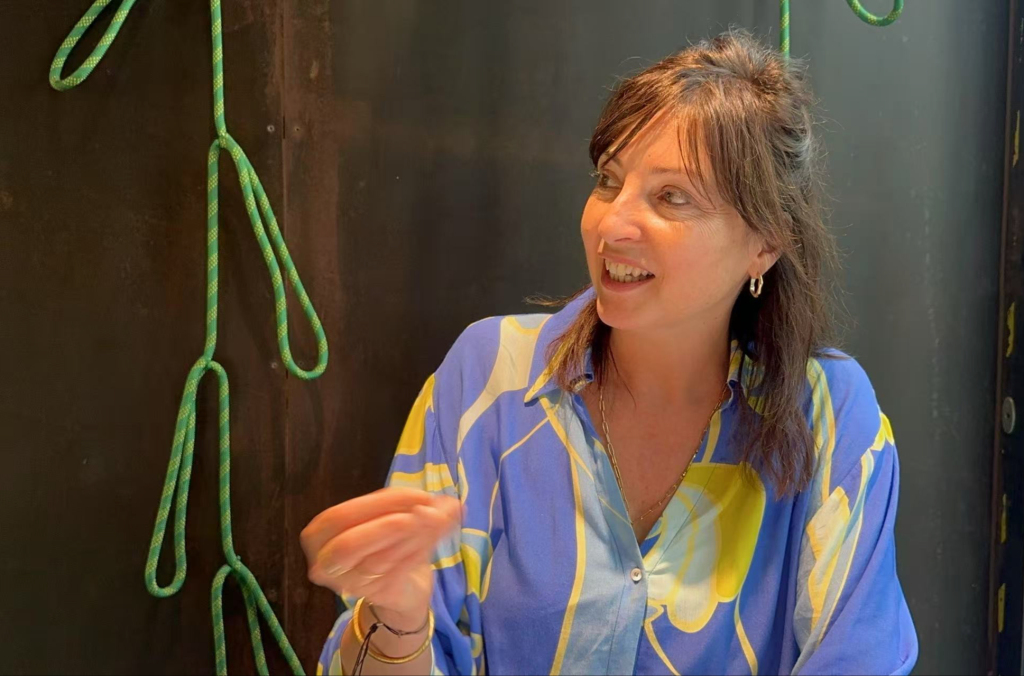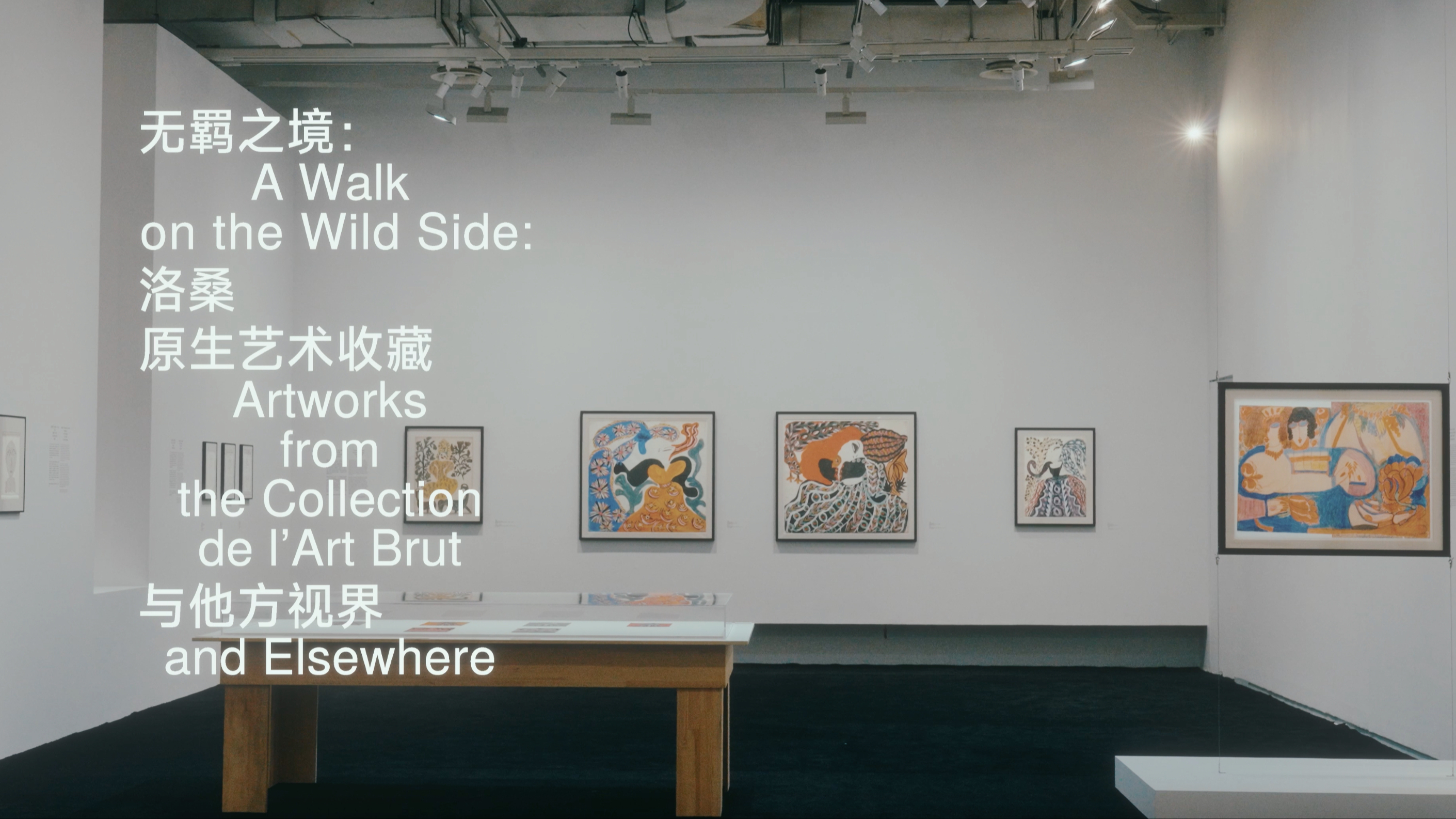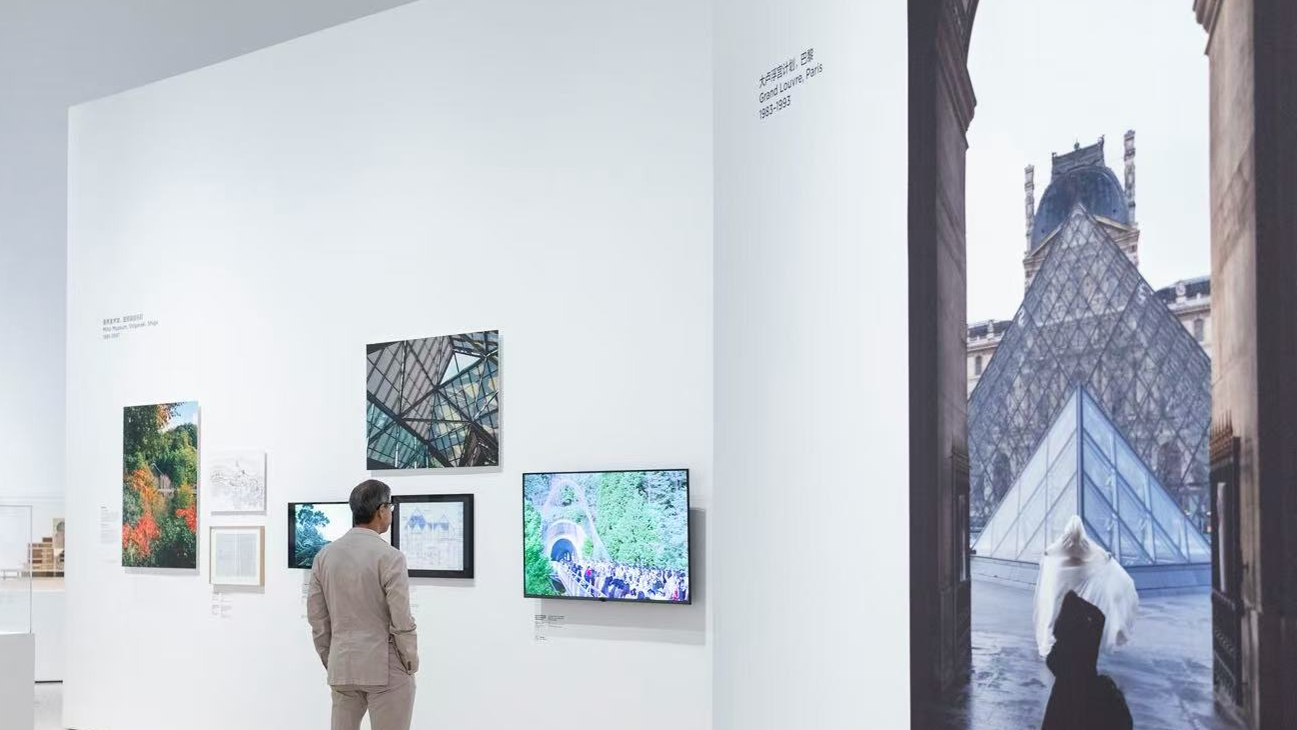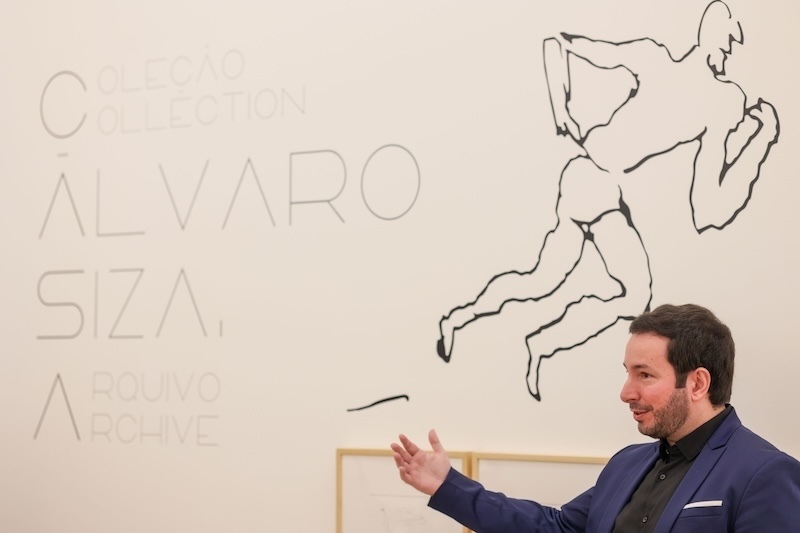
The emergence of the term "brut" and the existence of the Collection de l'Art Brut, Lausanne, Switzerland, are both attributed to French artist Jean Dubuffet (1901-1985). He discovered "brut" creators and donated his collection and brut archives to the city of Lausanne, Switzerland in 1971, which led to the opening of the Collection de l'Art Brut in 1976.
"Unfettered Realm: Art Nouveau Collection and Other Visions in Lausanne, Switzerland" is being exhibited at the Power Station of Art (PSA) in Shanghai these days; at the same time, the exhibition "Collage Works by Ding Liren" is also on display at the Art Nouveau Collection in Lausanne. In conjunction with these two exhibitions, Sarah Lombardi, director of the Art Nouveau Collection in Lausanne, Switzerland, recently accepted an exclusive interview with The Paper | Art Review in Shanghai. Lombardi said that art has a "wild path" and that art nouveau has a kind of "purity" without utilitarianism, which is very rare at the moment.

Sarah Lombardi, Director of the Lausanne Art Primitive Collection, accepts an exclusive interview with The Paper

Exhibition view of “Unbounded: Lausanne Art Primitive Collection and Other Perspectives” at Power Station of Art, Shanghai
In 2023, Sarah Lombardi visited China for the first time and visited the Power Station of Art (PSA) in Shanghai. Gong Yan, director of the Power Station of Art, showed her several collage works by Ding Liren in the museum's collection - a series of collages with a distinct insect theme that he taught himself after retirement. Soon, with the introduction of Gong Yan, Lombardi visited Ding Liren, who was over 90 years old, and after seeing more original works in his studio, she expressed on the spot her wish to exhibit his works in future exhibitions.
This led to the first exhibition of Ding Liren's works outside of China, and was also a new starting point for the dissemination of Chinese native art abroad.

Exhibition poster for the "Collage Works of Ding Liren" outside the Lausanne Art Primitive Collection
The “Unfettered World” exhibition brings together 233 collections from 49 artists from the Art Primitive Collection in Lausanne, Switzerland, as well as works by four self-taught Chinese artists including Guo Fengyi and Ku Shulan.
Both exhibitions were co-curated by the two museums, establishing a dialogue between the two institutions, which are respectively deeply engaged in the fields of contemporary art and native art.
However, what is "Art Brut"? In this regard, Sarah Lombardi started with the French artist Jean Dubuffet, the originator of Art Brut, and traced back the origin of this concept and its continuation and evolution in the contemporary context.
Jean Dubuffet and the Understanding and Positioning of Art Primitive
The Paper: How do you define Art Nouveau? How does it differ from other concepts such as “folk art” and “non-mainstream art”?
Lombardi: "Art Brut" is a concept proposed by Jean Dubuffet in 1945. Its core is those creators who have not received formal training in art academies and are completely self-taught. Their creations are mainly motivated by self-expression and inner needs, often inner impulses or even survival impulses, or purely for self-pleasure. They do not seek to become "artists" and have no intention of participating in exhibitions or gaining public recognition. In other words, this kind of creation exists first for the creators themselves, in response to their own creative impulses or inner needs.

Jean Dubuffet playing with Jeanne Léger's monkey during his military service, 1924, gelatin silver photograph. © Fondation Dubuffet, Paris
The related "folk art" is also mostly created by self-taught people, but their works are usually based on specific culture or local traditions, expressing the artistic themes and customs of a certain country or region. Although the techniques are naive and simple, they retain the connection with a certain folk custom or collective tradition. The creators of native art do not have any common cultural or artistic traditional background. Everyone expresses his or her own inner world, obsession and fantasy. The works of each native artist are self-contained and unrelated. The common point between the two is that neither has received formal art education.

Exhibition site, photos of Art Nouveau
As for "Outsider Art", it is the official translation of "Art Brut" in the English-speaking world, but it covers a wider range. It not only includes native art, but also other non-traditional art forms such as graffiti and tattoos. Therefore, English-speaking countries often confuse the two and understand "native art" more broadly than in Europe.
But in Europe, "art brut" is usually limited to the creations of self-taught people, and these creators are often on the margins of society (including retired people, socially excluded people, mentally ill people, prisoners, etc.). This is also the group that Dubuffet referred to when he first proposed this concept.

Distributing mulled wine at the market: Dubuffet next to Ets agent M. Luchel (hat in hand), January 1, 1942, print from negative, dimensions: 37 x 49.5 cm. © Fondation Dubuffet, Paris
The Paper: What kind of social background was Dubuffet facing when he proposed the concept of Art Brut? What kind of mainstream art system did he oppose?
Lombardi: Dubuffet briefly studied art at the Académie Julian in Paris for a few months, but he soon dropped out because he found the courses too boring and he didn't learn anything. The art world at that time was highly institutionalized, and becoming a "recognized" artist almost meant having a formal art education. Self-taught people were excluded from the system and had difficulty gaining recognition.
More importantly, the French art world in the 1940s was promoting abstract art. Traditional media (such as oil paint and canvas) were regarded as mainstream, and abstract painting became the "orthodox" artistic language. Dubuffet was extremely disgusted with this - not only disgusted with materials and techniques, but also rebellious against the entire bourgeois art system. He did not accept those standardized and normalized aesthetics and value judgments.

Jean Dubuffet at El Goréa, 1948, gelatin silver photograph. © Fondation Dubuffet, Paris
Therefore, he took the initiative to step out of the mainstream system and began to visit places far away from art centers, such as mental hospitals. In places without an art system, untamed original expressions may be born. It is in these marginal places that he saw the possibility of "original art".
In 1945, he first came into contact with the works of mental hospitals and prisoners, and began to construct the concept of "raw art". For him, this was not only a discovery of another art form, but also a practice of resisting the mainstream art power structure at that time.

The House of Art Brut in the basement of the René Drouin Gallery in Paris, 1948. From the collection of the Art Brut Collection, Lausanne, Switzerland.
The Paper: In your opinion, how does Dubuffet’s dual identity as an artist and a collector influence his definition and selection of “art brut”?
Lombardi: It is precisely because Dubuffet himself is an artist that the concept of "art brut" was established. He has the sensitivity and judgment from within art, and can recognize art in places that have never been regarded as "art". For example, when he walked into a mental hospital and saw the works of marginalized people, he could say: "This is art."
He is in the art system, but he also questions and breaks through it. It is this identity of "being present and rebelling" that makes him qualified to recognize the works of Adolf Wölfli and other creators as "art".

Jean Dubuffet sculpting in his studio on rue Labrouste, shaping a piece of Styrofoam with a hot cutting tool, October 2, 1970, gelatin silver. Photo by Kurt Weiss. © Fondation Dubuffet, Paris
"Art brut" also influenced Dubuffet's creations in turn. It was through contact with these non-traditional creators that Dubuffet gained a great sense of freedom in the use of materials. Native artists often use everyday materials such as mud, coal, and shells because they cannot obtain traditional art media, but they have a strong desire to express themselves, so they create a purely personal visual language.
This creative method made Dubuffet begin to reflect on the idea that art must rely on specific materials and academic techniques, and she tried to paint in unusual ways. More importantly, he learned from Art Primitive that art does not need to cater to the market or the audience, but comes from the impulse and expression of life.
He once said something very meaningful: for many artists, their role models are Picasso or Leonardo da Vinci, but his role models are Aloïse Corbaz and Adolf Wolfli. He regarded these original artists as true creators.

Adolf Wolfli, Untitled (Budapest Time Wheel), circa 1922, Colored pencil and pencil on paper, 50.4 x 65.3 cm. Collection Art Nouveau Lausanne (Switzerland). © Arnaud Conne, Digital Studio - City of Lausanne
The Paper: What is the relationship between Dubuffet’s works and Art Primitive?
Lombardi: I think what Dubuffet really learned from the “Art Brut” artists was how to maintain freedom in his own artistic practice.
They can use all kinds of materials without scruples and express themselves as they please. Dubuffet admired this creative dimension very much, and it became an important turning point in his artistic thinking.

Jean Dubuffet, "Happy Countryside", August 1944, oil on canvas, 130.5×89 cm, purchased in 1981, National Museum of Modern Art - Industrial Design Center, Centre Pompidou, Paris (currently on display at West Bund Art Museum, Shanghai)
But at the same time, we must make one thing clear: Dubuffet did not consider himself an "art brut" artist. Although he only studied at the Julian Academy for a few months, he had received art education and had a deep understanding of art history and cultural traditions.
So he is not a member of "art brut" nor an "outsider". He was the first person to propose this concept and the first to systematically collect such works outside the mainstream system. He built a platform that allowed creations that were not originally considered "art" to gain cultural and aesthetic legitimacy for the first time.

Jean Dubuffet working on his “Materialism” series in his studio in Vence, 1960, gelatin silver. Photo by Jean Weber. © Fondation Dubuffet, Paris
The Paper: What were Jean Dubuffet’s considerations for donating his collection to Lausanne?
Lombardi: Jean Dubuffet chose to donate his Art Brut collection to Lausanne, Switzerland, first because he encountered setbacks in Paris. He had hoped that the city of Paris would recognize the artistic value of these works and provide support, but he did not receive approval. Dubuffet believed that the art system in Paris did not truly understand Art Brut and did not recognize the true value of these works.
It was during that time that he met Michel Thévoz, who later became the first director of the Lausanne Art Brut Collection. But at the time, Thévoz was still a young scholar who was writing a doctoral thesis on Brut artists. Thévoz often visited the Compagnie de l'Art Brut, a space set up by Dubuffet in Paris to preserve his collection. Through frequent exchanges, Thévoz showed his understanding, enthusiasm and recognition of Brut art. So he asked if he could try to find a home for this collection in Switzerland.

Slavko Kobak, Michel Tewarts and Jean Dubuffet at the Collection Art Nouveau, Lausanne, Switzerland, February 1976. Photo by Jean-Jacques Lesser. Collection of the Collection Art Nouveau, Lausanne, Switzerland.
There was another deeper reason why Dubuffet finally chose Lausanne: in the summer of 1945, he went to Switzerland and took the initiative to visit local mental hospitals and prisons, trying to find art forms outside the academic system. It was during this trip that he first came into contact with brute art creators such as Adolf Wolfli. That experience was extremely important to him and was the starting point for his discovery of "brute art".
Therefore, in terms of both emotion and history, Switzerland has become the most natural and symbolic home for this collection, which is also the reason why the Lausanne Art Primitive Collection was born.

The exterior of the Art Primitives Collection in Lausanne, Switzerland. Photo by Caroline Smilyliadis. Collection of the Art Primitives Collection in Lausanne, Switzerland.
“Art Brut” in the Present: Purity Beyond Market Logic
The Paper: How does the Lausanne Art Primitives Collection extend and revise its definition of “primitiveness”? Or how has Dubuffet’s concept of “primitive art” evolved in the present?
Lombardi: To this day, we still use Dubuffet’s basic definition of “art brut.” When we look for new brut artists, the criteria remain the same:
Firstly, the creators must be completely self-taught, and their creations must be self-driven and motivated by an intrinsic “necessity” of expression, rather than for recognition from the public, the market or the art system.
Secondly, we look at whether the work itself has artistic value. Although this is a subjective judgment, we always look for works that are highly unique - they often show a distinct personal language, internal obsessions, self-constructed worlds, and ways of representing reality that we have never seen before.
This is the standard of judgment we adhere to today as we continue to expand indigenous art.

Exhibition view of “Unbounded: Lausanne Art Primitive Collection and Other Perspectives” at Power Station of Art, Shanghai
Of course, there are some key changes to Art Brut today compared to Dubuffet’s time. Most obviously, we hardly ever find new artists emerging from asylums.
Because, the drug treatment in mental hospitals today can control hallucinations and delusions and help them recover, but it also suppresses their imagination and impulse to improvise; moreover, modern mental hospitals often have art therapy workshops, the starting point of which is to help patients recover through painting and other means. However, this kind of creation is often guided and intervened, and is not completely free to express. Therefore, it no longer belongs to the category of "original art".
So now we find that native artists are more likely to be in some "workshops". These workshops are often spontaneously founded by artists, providing completely free creative space for people with disabilities. There, participants express themselves without interference, which is closer to the essence of "native art".

Davoud Kuchaki, Untitled, 2016, pencil on paper, 100 x 70 cm. Collection Art Primitive Lausanne (Switzerland). © Claudina Garcia, Digital Studio - City of Lausanne
Another group that deserves attention is the elderly. In today's social structure, the elderly are gradually becoming a new "marginal group". Among them, we have found many highly creative individuals. Their artistic practice is not driven by external expectations, but responds to personal life, memory and existence. This is also an important direction of change in native art: the "marginality" of the creator is no longer equivalent to mental illness, but more broadly refers to the state of social isolation.

Gregory Lee Blackstock, Shed, 2013, pencil, colored pencil and marker on glued paper, 105.5 x 61 cm. Art Brut Collection Lausanne (Switzerland). © Charlotte Aebischer, Digital Studio - City of Lausanne
The Paper: Is “Art Brut” still critical and contemporary?
Lombardi: The current art system is largely dominated by money and economic value. People buy art for appreciation or even investment arbitrage.
The significance of Art Nouveau is precisely the opposite of this logic. It comes from a creative state that does not care about the market, money, or audience feedback. This may be called "pure" - this word sounds a bit special, but I think it is very appropriate.
The so-called "pure" is an expression that comes completely from the heart without any speculative calculation. In contemporary art, such a way of creation is becoming increasingly scarce. Of course, I am not saying that all contemporary artists are profit-seeking, but we do see that today's art ecology is increasingly dependent on large galleries, fairs and other institutions, and most of these systems are business-oriented.
In contrast, art brut has never been aimed at the market. Of course, it must be admitted that in the past 20 years, art brut has inevitably been absorbed by the market. There are already galleries specializing in art brut, and Sotheby's, Christie's, etc. also auction this kind of work.
Just like graffiti art, the market will eventually incorporate everything into its system. But even so, Art Nouveau still represents a way of creation that is out of the market logic and away from the art criticism system. I think this is what makes it unique and irreplaceable in the contemporary art landscape.

Hans Klusy, Untitled, 1982, stencil, spray paint and marker on paper with tape, 70 x 100 cm. Art Primitive Collection Lausanne (Switzerland). © Marie Humair, Studio Digitisation - City of Lausanne
Two art museums with different positioning hold dialogue over “art brute”
The Paper: This is the first time that the Lausanne Art Primitives Collection has held a large-scale research exhibition in mainland China. “Art Primitive” was born in a specific French modernist context. When presenting it in China today, does it need to retranslate its concepts and core?
Lombardi: In fact, when Gong Yan (Director of the Power Station of Art) first came to our museum and proposed to organize an exhibition on Art Primitive in China, the question that came to my mind was: Can Chinese audiences really understand Art Primitive?
But she told me that she was not worried at all, because China has a very deep tradition of folk art - from paper cutting and shadow puppetry to folk stories and oral legends, all of which originated from creators who were not trained in academies.

Ku Shulan, "Big Sister, Dressing Up Cleverly", 1983, paper cut collage, 54×39 cm, private collection
In her opinion, precisely because the Chinese people themselves respect folk art very much, they will find it easier to understand native art, because the two are connected on some levels - they are both created by non-scholars and are non-mainstream expressions of daily life and the inner world.
I find this answer very inspiring, and it makes me realize that perhaps Chinese audiences can really approach the works and concepts of indigenous art in a sincere and open way.

The exhibition site of “Unfettered Realm: Lausanne’s Native Art Collection and Other Perspectives”, with works by Chinese native artists
The Paper: The exhibition title “Walk on the Wild Side” has a strong metaphorical connotation. How did the title come about? What kind of viewing state do you hope the audience will enter?
Lombardi: “Walk on the Wild Side” comes from the title of a song by Lou Reed, which means, “Walking on the other side of the art world.”
The art system we know today is often dominated by the market, large galleries, auction houses, art critics, etc., forming an "official path". And what Art Aboriginal represents is another path outside the edge of this official system. This "wild path" is the symbol of Art Aboriginal. And what the title of the exhibition expresses is to invite the audience to walk into the "other side" of art, to discover Art Aboriginal and to take a different path.
I hope the audience can feel that art does not belong to only one class. It not only exists in empowered art galleries and markets, but also in the creations of marginalized groups. Art is everywhere, belongs to everyone, and can be created by everyone.
Of course, what is more important to be an artist is whether you have something you want to say in your heart and whether you have a rich spiritual world waiting to be expressed.

Exhibition view of “Unbounded: Lausanne Art Primitive Collection and Other Perspectives” at Power Station of Art, Shanghai
The Paper: This exhibition includes works by 49 native artists and four self-taught Chinese artists. What are you most concerned about when selecting works?
Lombardi: We have several key criteria when selecting works.
First of all, there are artists from different countries and regions, including artists from Europe, such as a group of large paintings by Adolf Wolfli, one of the first artists discovered by Jean Dubuffet and one of the most representative figures in Art Primitive. There are also works by Aloïse Corbaz, a female artist born in Switzerland, who is very famous in Europe and her works are full of dreams and passion.

Aloise Corbaz, Untitled (Château de Vincennes), 1941-1951, colored pencil on two sheets of paper stitched together, 69.5 x 175.22 cm. Collection Art Nouveau Lausanne (Switzerland). © Claudina Garcia, Digitization Studio - City of Lausanne.
The exhibition also features artists from Asia, South America, Japan, etc. We hope that the audience will see that although the concept of “Art Brut” was proposed by French artist Jean Dubuffet in Europe, its spirit can be echoed all over the world, reflecting a cross-cultural and cross-contextual creative power.
Secondly, we also pay special attention to the diversity of media and forms. The exhibition includes paintings, sculptures, fabric installations, stone carvings and other works, ranging from very small paper to large-scale works. We hope to let the audience see the vastly different languages and material choices in the world of native art.

Judith Scott, Untitled, 2003, wool, fabric, hay and cardboard, 34 x 45.5 x 37 cm. Art Primitive Collection Lausanne (Switzerland). © Studio Digitisation - City of Lausanne
In addition, there is another particularly important presence - Chinese artist Guo Fengyi. Her works are collected by both the Lausanne Art Primitive Collection and the Shanghai Power Station of Art. In this exhibition, her works come from both institutions.
Through Guo Fengyi’s work, we have built a bridge between two museums with very different positioning: on one side is the Lausanne Collection, which focuses on Art Nouveau, and on the other side is the PSA, which focuses on contemporary art. And Guo Fengyi just embodies the core spirit of Art Nouveau—her work is highly spiritual and spontaneous, completely outside the mainstream art system.
She is not only the intersection of Chinese and Western cultures in the understanding of "original art", but also symbolizes the possible development path of this art form on a global scale.

Guo Fengyi, “Heavenly Girl Scattering Flowers”, 1990-2008, pigment and Chinese ink on rice paper, 148 x 46 cm. Lausanne Art Primitive Collection (Switzerland). © Marie Humair, Digital Studio - City of Lausanne
The Paper: What do you think of Ding Liren’s works at the “Collages of Ding Liren” exhibition currently being held at the Art Primitive Collection in Lausanne (2025/6/13 -10/27)?
Lombardi: This exhibition displays 39 collage works provided by Mr. Ding Liren. The 95-year-old man came to the opening ceremony of the exhibition with his son and grandson, and you can see that he was very happy.

Ding Liren and Lombardi pose for a photo at the opening of “Ding Liren’s Collages” in Lausanne.
Ding Liren's work touched me because it is distantly related to traditional Chinese folk paper-cutting in form, but is completely independent of existing techniques. He developed his own language of cutting and collage: he collected images from fashion magazines, cut them up and reassembled them to form images of various insects.

Exhibition view of Ding Liren’s Collages at the Lausanne Art Primitive Collection
These creations are deeply rooted in his personal experience. As a biologist, Mr. Ding Liren has long studied entomology and worked as a specimen painter in a natural history museum, drawing highly realistic insect atlases. After retirement, he was no longer satisfied with accurate reproduction, but began to "redraw" insects in a collage way - giving them flying and dancing postures, allowing them to "revive" from scientific specimens, become full of vitality, and overflow with a pure joy. These works are no longer rigorous scientific illustrations, but a free extension of his memory and imagination.
The exhibition “Unbound: Lausanne Art Primitive Collection and Other Visions” will run until October 12.


